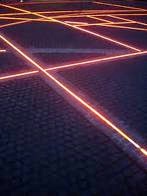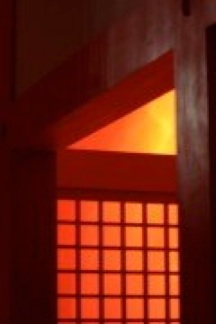8
technology -
towards a deep ecology of art, architecture and being
research project of goldsmiths, university of london
8
technology -
towards a deep ecology of art, architecture and being
research project of goldsmiths, university of london
director: raphael jay adjani
associate: sian ni mhuiri
red cube concept-philosophy
red cube is a translucent one room house made of vermillion red polycarbonate, that pops up in communal spaces all over the world: playgrounds, parks, squares, housing estates, centres of art, shopping malls. Each time the red cube pops up it develops a particular relationship to its external space, the people, who live there and who may frequent the cube; and they develop a unique relationship with the cube. Each appearance will have its own particular flavour and atmosphere, which could involve participation and collaboration of local people in unique ways as well as the use of various media in the surrounding space – like LED light, sound, video projection, and sometimes a particular one-on-one performance experience – which the artist describes as a ‘contemporary tea ceremony without tea’.
red cube combines architecture, science, digital and everyday technology, Asian philosophies and Japanese aesthetics to create a work that is simple in design yet splendorous, deeply thought-provoking yet accessible to any and all people who wish to enter.
The arrival of the cube becomes the starting point of a particular reflection on the relationship between people and the space in which they live and frequent.
red cube offers a sanctuary for people to sit, lie, listen to music, read a book, tap a laptop, tweet to their hearts content or simply enjoy the colourful passing of clouds and people viewed through the red ceiling and walls.
red cube is designed and manufactured so that it is easy to assemble and dismantle, light and easy to transport and tour to any communal space in the world. The assembly of the cube each time by the artists is part of the ritual process and preparation that may culminate in a ‘tea ceremony’.
Being in the cube with an artist is an experience for the participant akin to Japanese tea ceremony, with its philosophy, sensuous ritual, therapeutic immersion, sensory interaction and everyday technology. As you sit in the cube you may sense a greater appreciation for both inner and outer worlds. You are inside yet still aware of your relationships to the wider space and city beyond; becoming more sensitised to the time, place, season, mood, other beings, architecture and landscape. Perhaps paradoxically, entering the inner space of the cube one becomes more sensitive to the greater external space.
Building on a Buddhist idea that we exist only in relationship to everything else, red cube draws attention to what is called ‘deep ecology’ – not just green concerns but how people are intimately integrated into a wider web of life.

red cube series
conception direction: ajaykumar

8 technology a.k.a. ecosophy 8 a.k.a. 8
brings together particular ideas from science, digital technology, philosophy, architecture and art to facilitate sublime works that shed light on our contemporary ecology and being.
this site is both ‘art ‘ and ‘information’ in that it can tell you about what 8 does, at the same time it is created and tended near daily, in a deliberate, ritualised process of re-construction and re-creation, according to mood, season, context,
-a durational work without duration -
a ‘technology’ of the every day,
in the manner of a daily tea ceremony or tending of a zen garden, for your pleasure...
each page is unique: constructed with minor compositional variation.
spot the deliberate imperfections.
view via the sublime filmic work, version for the internet: naka-ma
connect with 8 technology’s daily twitter
join the evolving discussion at facebook